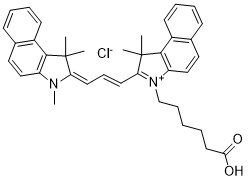810349 | Cyanine 3.5 NHS
3-(6-((2,5-dioxopyrrolidin-1-yl)oxy)-6-oxohexyl)-1,1-dimethyl-2-((1E,3E)-3-(1,1,3-trimethyl-1,3-dihydro-2H-benzo[e]indol-2-ylidene)prop-1-en-1-yl)-1H-benzo[e]indol-3-ium chloride

Please Confirm Your Location
Effective March 1, 2018, Merck KGaA, Darmstadt, Germany* is the exclusive Distributor of Avanti Research. Research Products for all countries except the United States. For product pricing and order placement, please click on the appropriate Location Box below.
For customers located outside the United States, you will be redirected to www.sigmaaldrich.com/avanti prior to completing your purchase. Thank you for your continued business and support of Avanti Research!
*The life science business of Merck KGaA, Darmstadt, Germany operates as MilliporeSigma in the U.S. and Canada
Cyanine 3.5 NHS
3-(6-((2,5-dioxopyrrolidin-1-yl)oxy)-6-oxohexyl)-1,1-dimethyl-2-((1E,3E)-3-(1,1,3-trimethyl-1,3-dihydro-2H-benzo[e]indol-2-ylidene)prop-1-en-1-yl)-1H-benzo[e]indol-3-ium chloride
Cyanine 3.5 NHS is an amine-reactive, orange-red fluorescent probe engineered for precise and efficient covalent labeling of proteins, peptides, and other biomolecules containing primary amines. Often referred to as a Cy3.5 dye, this reagent is better described as a fluorescent probe because its NHS ester group enables stable covalent attachment to biomolecules.
Functionalized with an N-hydroxysuccinimide (NHS) ester, it conjugates under mild aqueous conditions, offering strong fluorescence (~580–600 nm), high water solubility, and superior photostability compared to many traditional probes.
Application
This probe does the heavy lifting for protein and antibody conjugation in immunofluorescence, Western blotting, and flow cytometry. It excels in live and fixed cell imaging, delivering bright, stable signals under fluorescence microscopy. Researchers have also found it useful for nucleic acid labeling in hybridization studies, in-gel visualization, and FRET-based high-throughput screening.
Cyanine 3.5 NHS's excitation/emission profile (~580 nm / ~600 nm) minimizes spectral bleed-through into far-red channels, enabling cleaner multiplex experiments. NHS ester chemistry ensures reproducible coupling to lysine residues, especially at pH 7.5–8.5, while its water solubility and low nonspecific binding make for clean, clear images. Compatible with most amine-free buffers (e.g., PBS, bicarbonate, MES), it's an ideal choice for microscopy and flow cytometry workflows where precision is essential.
Packaging
Avanti Research™ provides Cyanine 3.5 NHS in 5 mg powder packaging with bulk pricing available upon request.
With decades of expertise advancing fluorescence labeling technologies, our team at Avanti Research™ continues to set the standard for precision, purity, and consistency. We maintain a leading position in the scientific community for lipid research and development.
FAQs
What is the difference between Cyanine 3 and Cyanine 3.5 fluorescent probes?
Cyanine 3.5 emits light at a slightly longer wavelength, reducing spectral overlap and boosting brightness for flow cytometry.
Can I use Cyanine 3.5 NHS to label antibodies in PBS?
Yes, as long as the buffer does not contain free amines like Tris or glycine. Standard PBS or bicarbonate buffers are also compatible.
How stable is the NHS ester once dissolved?
It hydrolyzes quickly in water. For the best results, label it immediately after dissolving in anhydrous DMSO or DMF.
Related Products
Explore complementary reagent products for multi-fluorescent labeling from Avanti Research™ using the buttons below.
| C42H44ClN3O4 |
CAS Registry Number is a Registered Trademark of the American Chemical Society



